We have no permanent natural water on the place. But when it does rain, we have a variety of temporary water sources, from the actual creek to the various overflow channels (some of concern because of erosion; others now pretty much “tamed.”)
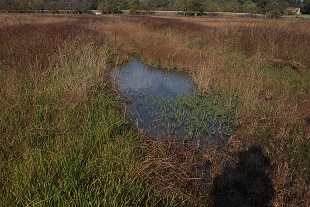
When we moved here, this ditch, intended to drain the east grass, ran from the highway culvert (that white blip up by the road) all the way to the south fenceline, on a shallow diagonal. Trees grew up alongside and in the ditch, taking advantage of the extra water. Cattle had broken down the ditch sides in several places, and in floods the water escaped to the south, the natural drainage. You can see in the following image the line of what is now a grass waterway (paler grass) across the near meadow from the end of the tree line:
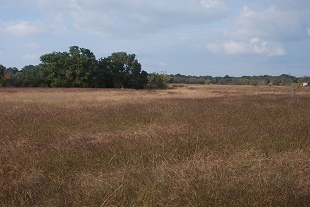
When we bought the place, and this area was badly overgrazed, a torrent of muddy water tore at the soil along that line and kept much of it bare. A series of checkdams upstream, especially where the ditch and the natural drainage met, and a large gabion shortly below the breakthrough, tamed this drainage system.
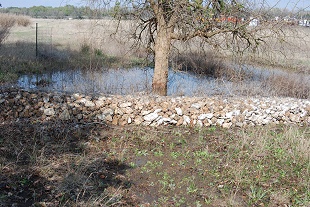
Pools like this provide water for all classes of wildlife, and habitat for those requiring water for reproduction or shelter: this area is surrounded by crayfish burrows and chimneys, and supports a population of odonates and aquatic insects. Pools behind checkdams and gabions provide water longer than those without, simply because they can hold more water.
But natural pools are also important and can be improved with good management. That first image shows that the original ditch is now wider and shallower than it was, and heavily vegetated on the sides and most of the bottom. Flood pulses of different amounts have deposited debris here and there, which then was stabilized by vegetation, allowing the creation of a sequential pools, each one a tiny habitat. I walked the length of the ditch today, and all the way up I found water–little pools like that one, little trickles of water between them–ideal habitat for damselflies like these:
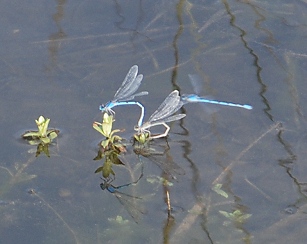
North of the ditch, the original sinuous drainage pattern had begun to re-establish itself before we bought the place, but due to overgrazing and trampling by cattle, it generated a fair bit of erosion. Now there’s less, thanks to the check dams, and a natural pool on that drainage looks like this:
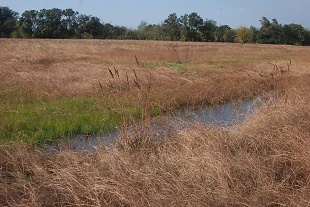
Although most of the grass visible is non-native, native sedges (the greenest stuff) have moved in and so have some native grasses and forbs. Flow here feeds the pool behind the #3 gabion. When the water table is high (as it is right now) less than an inch of rain will restore gentle flow through here; it comes from the slightly higher ground to the north as well as from the highway and hill beyond to the east. I flushed several grassland birds from along both the ditch and this natural drainage; these narrow, shallow waters offer dispersed water and feed (from grass seeds and insects) to both migrant and resident species.
The most striking of our temporary natural water sources is the “gully system” drainage west of the seasonal creek. It receives surface runoff from fields to the north and west, and flash-flood overflow from the creek (via a channel I don’t have a good picture of. When we bought the land, it was mostly empty of vegetation, and actively eroding both headward and out to both sides. Cattle had broken down the sides, crossing it, which contributed to the erosion problem. After four or five years without cattle, it had begun to mend but the problems were still evident in this picture from December 2005:
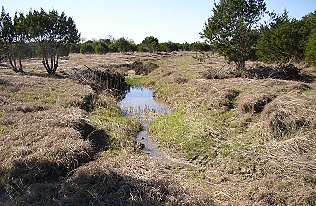
We had cleared Ashe juniper away from the banks (except for a few, trimmed up for shade) and the long gash had begun to make distinct pools, but it still looked bad. But good rains came in 2006-2007, and by May 2007 it looked like this:
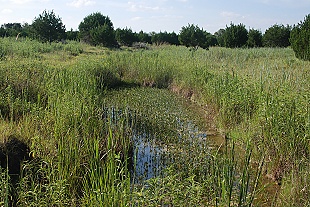
Rain ended in the fall of 2007, and we quickly fell into a serious drought; some of the grasses which here were holding the banks died back–so it doesn’t look this good now–but it looks a lot better than in 2005. These pools also have a full range of wildlife: odonates, other aquatic insects, frogs and toads, and crayfish, as well as providing water for deer, armadillo, fox, etc.
Even temporary accumulations of natural water matter to both wildlife and native vegetation. For one thing, it takes pressure off the supplemental water we provide, and gives us time to do repair and maintenance on pumps and pipes without depriving wildlife of vital water. For another, the higher groundwater gives native plants a chance to store water in their deep root systems. Managing for less erosion (ideally none) inevitably creates temporary pools and marshy places that attract and support a greater variety of wildlife–and new native plants–to the place.
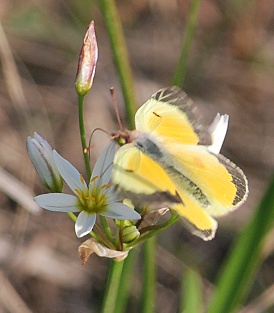
The wet areas with their damp ground plants attract more than thirsty deer and rabbits…here a wild onion has brought in an Orange Sulphur butterfly. In the same area, one of the small Blues (not sure which) also nectared on wild onion.
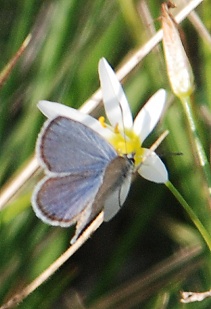
Comment by green_knight — November 10, 2009 @ 9:39 am
As always, thank you for posting these. I can only guess how much effort and research goes into creating what seems like a ‘natural’ environment – I knew restoration was hard work (because once a habitat is destroyed, all too often secondary habitats develop that outcompete the original inhabitant; at least that’s the case in much of Europe, and IIRC in Amazonian rainforests).
Tieing in with yesterday’s discussion (and I know your place is only small and that encouraging wildlife is your priority, and rightly so): how well do you think that livestock keeping could coexist with the general work you’re doing, or are they just too destructive?
Comment by elizabeth — November 10, 2009 @ 9:57 am
Livestock can co-exist with wildlife management very easily in some situations–for instance, low-density grazing of grassland is actually beneficial to it. It does require having the acreage to keep the grazing at the level the land needs–and that varies with climate, soil type, grass varieties, etc. If I had 200 acres, where I am, I could certainly have a small herd of cattle (and would!)–10 cows, a bull, would be about right. Except for replacement heifers (keeping herd same size) every year the calves would have to go.
What’s needed then is management to prevent cattle from congregating in one area and trampling it (compacting soil, which reduces the water-holding capacity, leads to erosion in our heavy rains, and destroys vegetation), and from damaging natural waterways. So in smaller places (and around here 200 acres is small) you need more fencing (expensive, but necessary) and a management plan of the HILF variety (high-intensity/low-frequency grazing) and the willingness to sell off or move the herd early in a drought sequence. If I could a) build the right fencing, keeping cattle out of the creek woods and dry woods, and b) put a pair of cows on the main grass for three months a year–not the same three months on any given section of it–that would actually be good for the grass as it is now. Unfortunately, I have no place to put those cows the other nine months, and there’s no internal fencing at all (used to be but was defunct before we got the place.)
Grassland benefits from grazing within its capacity–the trick is managing livestock so they have the same effect as migratory wild grazers. The choice of species (sheep v. goats v. cattle) depends on a combination of climate and terrain and the manager’s ability to control the use of the resource.
Restoration ecology is a complex field (which I’m still learning about, bit by bit) because of the need to work with the often-dire starting conditions. One of my books points out that delay in making decisions can compromise the project.
Comment by green_knight — November 10, 2009 @ 2:37 pm
The cattle numbers were something I thought I vaguely remembered from an earlier conversation. I’m proud of myself of thinking of 80 acres as ‘small’ because around here, we’re in ‘2.5 acres will feed a horse for a year *including* the making of your own hay’ country – AFAIK that more or less translates to one cow per acre, at least on the better pastures.
Around here – don’t know whether that would work for your cattle and your grazing- cows can be managed with electric fencing, which makes moving them *so* much easier and cheaper. (Horses, too – outside fences need to be sturdy, but effective dividers can be as little as a single strand of tape.)
As for restoration work as a whole, I think there are three phases (which might, to a degree, become consecutive): damage control (stopping erosion/invasive plants/contamination), base level restoration, and enhancement/diversification. If, for some reason, you have to stop after the first stage (because you’re running out of money etc) you will still have done good, but if you’ve poured your energy into the shiny parts trying to reconstruct specific habitats and fail, not much will have changed; and you can easily find yourself without the foundation you need to move on.
Comment by elizabeth — January 20, 2010 @ 12:12 am
You’re right about the need to pick the right early interventions for long-term success.
My applied ecology prof said that if you managed your water resources, the land would take care of itself–that the critical thing was always to stop erosion, hold water on the land, minimize runoff (and at least have better quality runoff–less silt.) Slowing erosion would promote revegetation, which further limits erosion, etc. So esp. in land already suffering erosion, the first thing to do (and it’s what we did first) is start slowing/halting runoff. Hold that rainwater on the land long enough for it to soak in, for grass and other plants to grow so their roots can hold more soil, etc. Then (simultaneously) start removing invasive non-natives doing damage and invasive natives doing damage, and start adding the long-lived woody stuff you want. He said no amount of replanting or fiddling with the landforms would work if you hadn’t done the critical water-management parts first. (And our experience bears that out.)
If you have a lot of money, you can make changes faster (if you have the wisdom to make the right changes) but if you don’t have a lot of money, transformation will take longer–but will still happen. It seemed like for several years that the land just barely reacted to our management…and then suddenly it took off, just like the textbooks said–the land wanted to recover–it was actually helping itself.
Because we’re doing it all ourselves, just two people (with occasional help of son), and we’re older, it goes slowly–but everything we do right makes a difference. Climate change isn’t helping–and yet, because I grew up in a hotter, drier climate than this one was 50 years ago, I can make a pretty good guess how to help this patch adapt to the change–what plants to introduce, for instance.